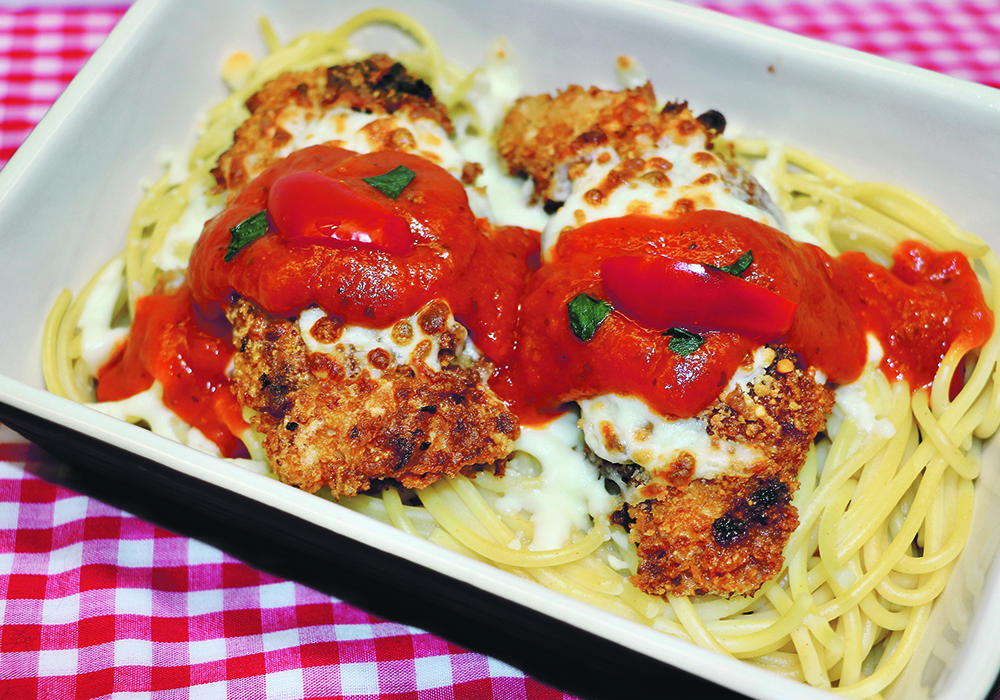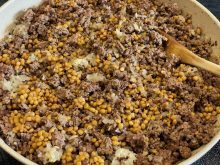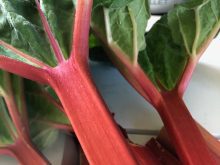With spring arrival, we begin to think of quick and easy meals that can be served during the busy farm season or when guests are coming.
Quicky and easy baked parmesan chicken
Serves four.
Premade pasta sauce makes this a quick meal to prepare. Using skinless and boneless chicken thighs helps to reduce the cost and are just as tasty as chicken breasts.
To make this recipe quicker buy chicken in bulk, cut, trim, and pound flat before freezing in recipe size plastic bags. Crush a large batch of corn flakes, add the parmesan cheese, seal in a plastic bag and freeze.
Read Also

Rural emergency room closures continue to be vexing problem
Staffing issues are at the root of disruptions and closures in hospital emergency departments, both in rural and urban Canadian locations.
To make, thaw chicken in refrigerator or place the plastic bag in a sink of cold water for 20 minutes, coat chicken pieces and bake.
- 4 boneless skinless chicken breasts or
- 4 – 6 boneless skinless chicken thighs
- Salt and pepperto season
- 1 – 2 c. corn flakes,crushed 250–500 mL
- 1/4 c. parmesan cheese 60 mL
- 1/2 c. mayonnaise 125 mL
- 1 – 2 c. mozzarella cheese, grated 250–500 mL*
- 1/2 c. parmesan cheese,freshly grated 125 mL
- 1/4 c. chopped freshbasil 60 mL
- 4 servings cooked pasta
- 1 640 mL jar tomato-based pasta sauce
* Use a mixture of fresh mozzarella, tangy provolone and real parmesan.
Place cornflakes into a plastic bag, use a rolling pin to crush into small crumbs. A food processor tends to turn the flakes into dust. Add quarter cup of parmesan cheese to crumbs, shake to combine.
Put about a third of this mixture on a plate for coating chicken pieces, adding more crumbs as needed. Extra crumbs left in the bag can be frozen for another time. Any extra crumbs that have been in contact with chicken must be thrown out.
Remove chicken tenders and cut thickest part of breasts horizontally to even out the thickness. Check chicken pieces for small bone pieces and remove.
Place chicken breasts or thighs between two sheets of heavy plastic (resealable freezer bags work well) or parchment paper, on a solid, level surface. Firmly pound chicken with smooth side of a meat mallet to a thickness of 1/2-inch (1 cm), this will help the meat cook more quickly and evenly.
Season chicken thoroughly with salt and pepper.
Place half of mayonnaise in a small dish. Using a pastry brush coat both sides of chicken with mayonnaise, add more mayonnaise as needed. Throw out any mayonnaise left in dish after chicken has been coated.
Place coated chicken in corn flake crumbs and cheese mixture. Firmly press chicken into crumbs, on all sides, to make crumbs adhere well.
Transfer crumb coated chicken pieces to a parchment lined baking sheet.
To allow coating to adhere to chicken, let sit for about 15 minutes before baking.
To make ahead the coated chicken can be covered and refrigerated for up to eight hours and then baked.
Preheat oven to 450 F (230 C). Bake chicken 12 minutes.
Cook pasta as directed on package.
Combine mozzarella and parmesan cheeses. Sprinkle a good layer on top of baked chicken.
Return to oven until cheese is browned and bubbly and chicken is no longer pink in the centre, about 10 minutes.
An instant-read thermometer inserted into thickest part of chicken should read at least 165 degrees F (74 degrees C).
Heat pasta sauce while chicken is baking.
To serve divide pasta between four dinner plates, top with chicken pieces, add two tablespoons of pasta sauce over cheese and garnish with fresh basil. Serve immediately with extra pasta sauce and cheese.
The key to non-soggy chicken parmesan is to not put any sauce under the chicken pieces, just add a little bit of sauce on top, so the breading stays relatively crisp. Adapted from rockrecipes.com
Lemon ricotta scones with cranberries
I love biscuits and scones and when I saw this recipe with ricotta cheese, I couldn’t wait to try it. It is now a family favourite.
The ricotta cheese and butter give a rich texture while the lemon and cranberries offer a refreshing flavour to these tender morsels. The scones are easy to make and can be frozen unbaked to provide fresh baked scones for a quick breakfast.
Yields: 16 pieces
- 2 c. all-purpose flour 500 mL
- 1 tbsp. baking powder 15 mL
- 1/4 tsp. baking soda 1 mL
- 1/4 tsp. salt 1 mL
- 1/3 c. granulated sugar 75 mL
- 2 tbsp. lemon zest 30 mL
- 1/2 c. cold butter, diced 125 mL
- 1 large egg
- 3/4 c. ricotta cheese 175 mL
- 3 tbsp. lemon juice 45 mL
- 1 tsp. almond extract 5 mL
- 1/2 c. fresh or frozen cranberries, chopped*
Glaze:
- 1 c. icing sugar 250 mL
- 2 tbsp. fresh lemon juice 30 mL
Place butter in freezer for 10-15 minutes before using to be sure it is well chilled.
Preheat oven to 400F (204C).
Lightly grease baking sheet or line with parchment paper.
In large bowl, combine all-purpose flour, baking powder, baking soda, salt, sugar, and lemon zest.
Cut cold butter into small cubes or use a grater to grate butter.
Using two knives or pastry cutter, cut in butter until well distributed to form small pea-size crumbs, don’t over mix.
In small bowl, whisk together egg, ricotta cheese, lemon juice and extract. Pour into dry ingredients and stir just until liquid is mixed in.
Mix in cranberries until dough starts to come together. There will be some loose crumbs remaining at the bottom.
Turn dough and crumbs onto a lightly floured surface. Press dough down with hands to form a rectangle, fold dough in thirds, pressing in flour and crumbs.
Repeat four or five more times until all extra flour is worked in. If dough is too dry, add one or two tablespoons of milk. If dough is too wet, add a little flour to counter and top of dough. If dough is sticky, refrigerate or freeze for a few minutes to chill.
Use hands to shape dough into a long rectangle about 16 by three inches (40cmx7cm).
Cut rectangle into four equal-sized squares, then cut each square in half to give eight pieces.
Cut each of those pieces diagonally to form two triangles, giving 16 triangular pieces.
Alternatively, for bigger pieces, shape dough into a large round about 1.5 inches high and nine inches in diameter (three cm x 22 cm). Cut into eight or 12 wedges.
Place pieces on baking sheet leaving space between each scone. Bake for 14 to 16 minutes until golden.
Remove from oven and place on wire rack to cool.
Glaze.
In small bowl, combine icing sugar and lemon juice. Stir well and gradually add more lemon juice as needed for icing to be smooth. Spoon into a snack size zip bag, close bag then cut just a small piece off a bottom corner. Squeeze glaze in a zig zag pattern across warm scones.
Let rest briefly to let glaze set. Best enjoyed while still warm out of the oven, or cool and store in airtight container for two days.
Freeze baked scones in airtight bag or container for up to three months. Thaw overnight and reheat in oven at 350F (180C).
Freeze shaped, unbaked scones on a baking sheet and then wrap tightly in airtight container for up to one month. Bake unthawed as described above adding up to five minutes.
*Replace cranberries with blueberries, cherries, saskatoons, rhubarb, peaches or any seasonal fruit.
Replace almond extract with vanilla or lemon extract.
The ricotta cheese adds extra fat for a tender dough and airy texture, as well as adding a nice flavour.
Avoid over stirring or kneading the dough too much because it will start developing the gluten in the flour. This is great if making bread, but not great when making scones. Tender scones need a firm but gentle touch. Just mix the dough enough to form it. Adapted from www.gettystewart.com.
Getty is a professional home economist, cookbook author and media spokesperson dedicated to helping you put good food on the table. She has a great website and recipes.
Betty Ann Deobald is a home economist from Rosetown, Sask., and a member of Team Resources. Contact: team@producer.com.
















